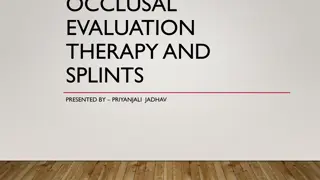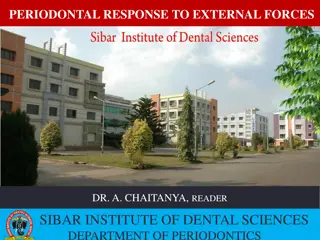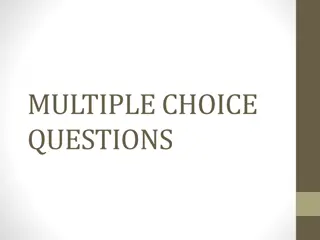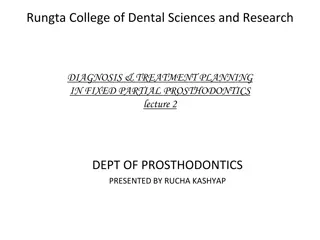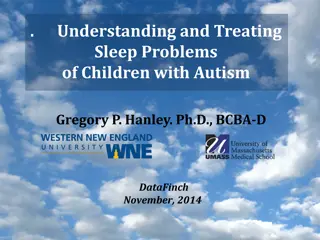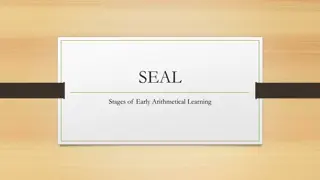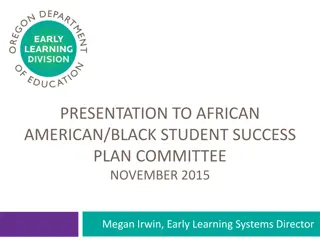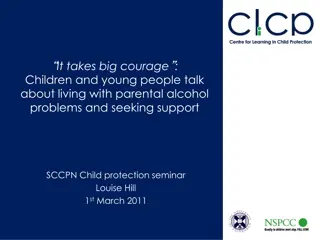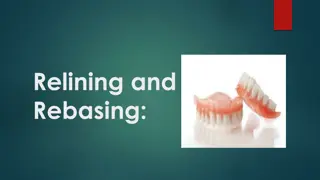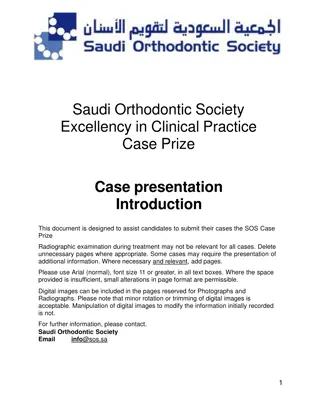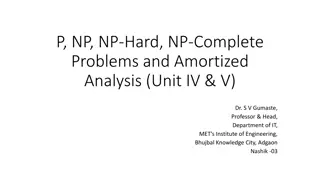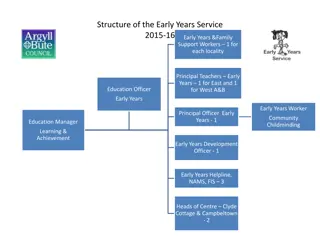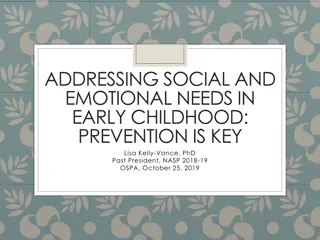Early Treatment of Occlusal Relationship Problems in Children
Dr. Somayeh Heidari, an orthodontist, discusses the treatment of occlusal relationship issues in preadolescent children. The importance of clear treatment goals, challenges in early intervention, and considerations for biomechanical differences in appliance types are highlighted. Anchorage control, space closure management, and potential risks like unerupted teeth are also addressed to ensure effective orthodontic care for young patients.
Download Presentation

Please find below an Image/Link to download the presentation.
The content on the website is provided AS IS for your information and personal use only. It may not be sold, licensed, or shared on other websites without obtaining consent from the author. Download presentation by click this link. If you encounter any issues during the download, it is possible that the publisher has removed the file from their server.
E N D
Presentation Transcript
Treatment of occlusal relationship problems in preadolescent children Presented by: Dr Somayeh Heidari Orthodontist
Reference: Contemporary Orthodontics Chapter 12 William R. Proffit, Henry W. Fields, David M.Sarver. 2007. Mosby
The goals of treatment must be clearly outlined and understood Problems of too long treatment: patient can be burned out the chance of damage to the teeth
Fewer options are available, and patient cooperation is more critical
There are important biomechanical differences between complete and partial appliances Typical fixed appliance for mixed dentition treatment: 2 4 2 6 ( 2 molar bands, 4 or 6 bonded anterior teeth)
2 4 or 2 6 : longer archwire span more springy and less strong wire light forces ( easier intrusion of teeth) appropriate moments more prone to breakage, distortion and displacement
Anchorage control is both more difficult and more critical Extraoral support ( Headgear or Facemask) and maxillary and mandibular lingual arches can be used Implant supported anchorage usually is not practical: unerupted teeth reduced density of the bone
Space closure must be managed with particular care Teeth without attachments may tend to be displaced and squeezed out of the arch
Interarch mechanics must be used sparingly if at all Interarch forces are not recommended under must circumstances with one exception: Cross elastics (in treatment of unilateral cross bite)
Retention often is needed between mixed dentition treatment and eruption of the permanent teeth wires can interfere with eruption of permanent teeth need to patient cooperation increase the chance of patient burn-out
Crossbites of dental origin usually affect only some of the teeth less sever than skeletal crossbites occlusal interferences often are present (increased chance of shift on closure)
Treatment in the mixed dentition is recommended because: Eliminates functional shift wear of erupted permanent teeth possibly dentoalveolar asymmetry Increase arch circumference Relapse is unlikely in the absence of a skeletal problem Simplifies future treatment
Posterior Crossbite treatment differs depending on its underlying cause dental crossbites are treated by moving the teeth with light forces heavy force and rapid expansion are not indicated in the primary or early mixed dentition significant risk of nose distortion
Basic approaches to the treatment of moderate posterior crossbite in children: equilibration to eliminate mandibular shift expansion of a constricted maxillary arch repositioning of individual teeth to deal with intra-arch asymmetries
A shift into posterior crossbite: in a few cases in primary or early mixed dentition due solely to interference caused by the primary canines diagnosed by careful positioning of the mandible require only limited equilibration of the primary canines
A greater maxillary constriction: allow the maxillary teeth to fit inside the mandibular teeth without shift on closure reduced arch circumference crossbite correction will provide more space small constriction creates dental interferences that force the mandible to shift
Whether or not a mandibular shift is present, a crossbite due to a narrow maxilla should be corrected when it is noted, in the primary or mixed dentition, unless the permanent first molars are expected to erupt in less than 6 months.
It is possible to treat posterior crossbite with a split-plate type of removable appliance, there are two problems: this relies on patient compliance for success the appliance can be displaced easily
The preferred appliance for modest expansion of the maxillary arch in a preadolescent child is an adjustable lingual arch. Both the W-arch and the quad helix are reliable and easy to use.
W-arch fixed appliance constructed of 36 mil steel wire soldered to molar bands activated simply by opening the apices of the W
easily adjusted to provide more anterior than posterior expansion, or vice versa delivers proper force when opened 4-5 mm wider than passive width should be adjusted before being inserted it is not uncommon for the teeth and maxilla to move more on one side
Quad helix more flexible version of W-arch the bulk of the anterior helices can effectively serve as a reminder to stop habit combination of a posterior crossbite and a sucking habit is the best indication greater range of action than the W-arch but the forces are equivalent
Both appliances: leave an imprint on the tongue, that will disappear when the appliance is removed some opening of the midpalatal suture can be expected in a young child expansion should continue at the rate of 2 mm per month ( 1 mm on each side) until the crossbite is slightly overcorrected intraoral appliance adjustment may lead to unexpected changes require 2 to 3 months active treatment and 3 months of retention
True unilateral crossbite: ideal treatment is to move selected teeth on the constricted side to a limited extent, this can be achieved by using different length arms, but some bilateral expansion must be expected
an alternative is to use a mandibular lingual arch to stabilize the lower teeth and attach cross-elastics to the maxillary teeth this is more complicated and requires cooperation, but is more unilateral in its effect
a third alternative is to use a removable appliance that sectioned asymmetrically this appliance has the same restrictions as all removable appliances
If teeth in both arches contributed to the problem: Cross-elastics between banded or bonded attachments in both arches the force has a vertical vector which will extrude the posterior teeth and reduce the overbite caution in child with increased lower face height or limited overbite
crossbite should be overcorrected, and attachments left in place immediately after active treatment when the occlusion is stable after several weeks without elastic force, the attachments can be removed. the most common problem is lack of cooperation from the child.
most children with anterior crossbite, especially if more than one or two teeth are in crossbite, have a skeletal problem the most common etiologic factor for nonskeletal anterior crossbite is lack of space for the permanent incisors if the developing crossbite is discovered before eruption is complete and overbite has not been established, the adjacent primary teeth can be extracted to provide the necessary space.
only occasionally the anterior crossbite treatment is indicated in the primary dentition dental anterior crossbites typically develop as the permanent incisors erupt those diagnosed after overbite is established require appliance therapy the first concern is adequate space bilateral disking extraction of the adjacent primary teeth opening space
if teeth are tipped when bodily movement is required, stability of the result is questionable. in a young child, the best method for tipping anterior teeth out of crossbite is a removable appliance
finger springs for facial movement of maxillary incisors one 22 mil double helical cantilever spring multiple clasps for retention labial bow is usually contraindicated active labial bow for lingual movement of lower incisors (less frequently)
Biteplate to reduce the overbite: usually is unnecessary in children unless the overbite is exceptionally deep it would be needed only in a child with a clenching or grinding habit using a biteplate risks the chance that the teeth not in contact with the appliance or opposing arch will erupt excessively
Removable appliance without biteplate 2 months Teeth in the opposite arch are moving in the same direction Biteplate is indicated and can be added to the appliance
This removable appliance : requires nearly full time wear if the springs are activated 1.5 to 2 mm, the teeth will move 1 mm in a month the offending teeth should be slightly overcorrected the teeth should retained until overbite is adequate to retention one or two months of retention with a passive appliance
The most common problems: lack of patient cooperation poor design leading to lack of retention improper activation
The simplest fixed appliance for correction of anterior crossbite: a maxillary lingual arch with finger spring ( whip spring ) indicated for a child with compliance problems the springs usually are soldered on the opposite side of the arch it will increase their length most effective if the length is approximately 15 mm
3 mm activation , will produce optimum rate of movement: 1 mm per month the greatest problems are distortion, breakage and poor oral hygiene
2 4 appliance: the best choice for an older patient with crowding, rotations and more permanent teeth in crossbite in mixed dentition
forces and moments produced on the anterior teeth by a rectangular archwire the torque and the coil springs tip the incisors facially multiple incisors can be readily corrected in a short time the roots of lateral incisors should not repositioned into the canine path of eruption


